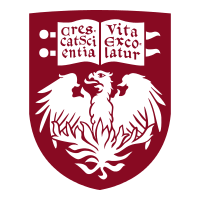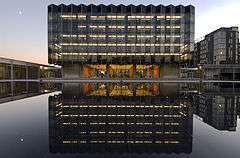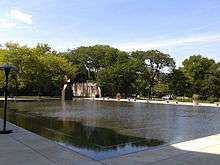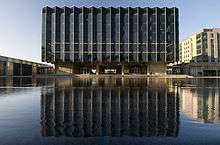University of Chicago Law School
| The University of Chicago Law School | |
|---|---|
 | |
| Established | 1902 |
| School type | Private |
| Dean | Thomas J. Miles |
| Location | Chicago, Illinois, USA |
| Enrollment | 604[1] |
| Faculty | 140[2] |
| USNWR ranking | 4[2] |
| Bar pass rate | 95.15%[2] |
| Website | http://www.law.uchicago.edu/ |
| ABA profile | The University of Chicago Law School |
The University of Chicago Law School is the graduate school of law at the University of Chicago. It was founded in 1902 by a coalition of donors led by John D. Rockefeller.[3]
U.S. News & World Report ranks Chicago fourth among U.S. law schools, and it is noted for its influence on the economic analysis of law.[4] The University of Chicago Law School was ranked third in the country by the 2015 Above The Law Rankings, which ranks law schools based on employment outcomes such as quality of jobs, federal clerkships, and alumni satisfaction.[5] Chicago is ranked second by Brian Leiter of the University of Chicago Law School on the "Top 15 Schools From Which the Most 'Prestigious' Law Firms Hire New Lawyers," and first for "Faculty quality based on American Academy of Arts and Sciences Membership."[6] It is ranked 12th in the 2016 QS World University Rankings.[7]
The Law School has the third highest gross and third highest per capita placement of alumni in U.S. Supreme Court clerkships (16% for the years 2000-08), according to Leiter,[8] with approximately 15-25% of each graduating class going on to a state or federal clerkship. The ABA disclosures indicate that 75% of Chicago graduates earned starting salaries of $160,000 or greater upon graduation. The law school was ranked # 3 of all law schools nationwide by the National Law Journal in terms of sending the highest percentage of 2015 graduates to the largest 100 law firms in the US (52.04%).[9]
History
University president William Rainey Harper requested assistance from the faculty of Harvard Law School in establishing a law school at Chicago, and Joseph Henry Beale, then a professor at Harvard, was given a two-year leave of absence to serve as the first Dean of the law school. During that time Beale hired many of the first members of the law school faculty and left the fledgling school "one of the best in the country."[10]
The Law School experienced a period of profound growth and expansion under the leadership of Dean Edward Hirsch Levi, AB 1932, JD 1935 (1945–1962). Levi later served as university Provost (1962–1968) and President (1968–1975), and then as United States Attorney General under President Gerald Ford. During his time at the Law School, Levi brought scholars to the faculty and supported the Committee on Social Thought graduate program.[11]
Academics

- Legal History Program
- The John M. Olin Program in Law and Economics
- International and Comparative Law
- Law & Philosophy
Policy Initiatives
- Animal Law Policy Initiative
- Climate Change Online
- Foster Care to Adulthood
Research Centers
- Coase-Sandor Institute for Law and Economics
- Center for Comparative Constitutionalism
- Center for Law, Philosophy, and Human Values
- Center for Studies in Criminal Justice
- Milton Friedman Institute for Research in Economics
D'Angelo Law Library

The D'Angelo Law Library is part of the greater University of Chicago library system. Renovated in 2006, it features a second-story reading room. The Law Library is open 90 hours per week and employs the equivalent of 10 full-time librarians. It has study space for 483, a wireless network, and 26 networked computers.
Admissions
Admission to The University of Chicago Law School is highly selective. For the class entering in the fall of 2015, 900 out of 4,111 applicants (21.8%) were offered admission, with 183 matriculating. The 25th and 75th LSAT percentiles for the 2016 entering class were 166 and 172, respectively, with a median of 170. The 25th and 75th undergraduate GPA percentiles were 3.69 and 3.97, respectively, with a median of 3.90.[12]
Grading
The University of Chicago Law School employs a grading system that places students on a scale of 155-186. The scale was 55-86 prior to 2003, but since then the school has utilized a prefix of "1" to eliminate confusion with the traditional 100 point grading scale. These numerical grades convert to the more familiar alphabetical scale roughly as follows: 155-159 = F, 160-167 = D, 168-173 = C, 174-179 = B, 180-186 = A. For classes of more than 10 students, professors are required to set the median grade at 177, with the number of grades above a 180 approximately equaling the number of grades below a 173.
In a 21 June 2010 article in The New York Times, business writer Catherine Rampell criticized other schools' problems with grade inflation, but commended Chicago's system, saying "[Chicago] has managed to maintain the integrity of its grades."[13]
A student graduates "with honors" if a final average of 179 is attained, "with high honors" if a final average of 180.5 is attained, and "with highest honors" if a final average of 182 is attained. The last of these achievements is rare; typically only one student every few years will attain the requisite 182 average. Additionally, the Law School awards two honors at graduation that are based on class rank. Of the students who earned at the Law School at least 79 of the 105 credits required to graduate, the top 10% are elected to the "Order of the Coif."[14] Students finishing their first or second years in the top 5% of their class, or graduating in the top 10%, are honored as "Kirkland and Ellis Scholars"[14] (a designation created in 2006 by a $7 million donation from the law firm of Kirkland & Ellis).[15]
Placement
According to the Law School's official 2015 ABA-required disclosures, 92.1% of the Class of 2013 obtained full-time, long-term, JD-required employment nine months after graduation.[16] The Law School's Law School Transparency under-employment score is 2.8%, indicating the percentage of the Class of 2013 unemployed, pursuing an additional degree, or working in a non-professional, short-term, or part-time job nine months after graduation.[17]
Chicago ranks second on Chicago Professor Bruce Leiter's "Top 15 Schools From Which the Most 'Prestigious' Law Firms Hire New Lawyers"; first for "Faculty quality based on American Academy of Arts and Sciences Membership"; third for "Supreme Court Clerkship Placement"; and fifth for "Student Quality".[18] The Law School had the third highest gross and third highest per capita placement of alumni as U.S. Supreme Court clerkships (16% for the years 2000-2008),[19] with Leiter reporting that approximately 15-25% of each graduating class going on to a state or federal clerkship.[20]
The law school was ranked # 3 of all law schools nationwide by the National Law Journal in terms of sending the highest percentage of 2015 graduates to the largest 100 law firms in the US (52.04%).[9]
Costs
The total cost of attendance (indicating the cost of tuition, fees, and living expenses) at the Law School for the 2013-14 academic year was $78,324.[21][22] The Law School Transparency estimated debt-financed cost of attendance for three years is $297,325.[23]
Publications and Organizations
Journals
The Law School produces six professional journals, and three are student-run: The University of Chicago Law Review, The Chicago Journal of International Law, and The University of Chicago Legal Forum. Students interested in membership on any of these journals participate in a writing competition at the end of first year. The Law Review selects 19 students for membership based on first year GPA ("grade on"), and 10 students for the quality of their writing competition submission ("write on"). The other two journals select members on the basis of writing competition submissions alone (without regard to GPA). All three student-run journals allow second and third year students to "write on" by submitting a piece of legal scholarship worthy of publication.
The Supreme Court Review, published by the law school and overseen by faculty since the 1960s, is the most cited legal journal internationally with respect to commentary on the nation's highest court. The faculty also oversees publication of the Journal of Law and Economics and the Journal of Legal Studies.
Academic Paper Series
The Law School produces several series of academic papers, including the Public Law and Legal Theory Working Papers, the John M. Olin Program in Law & Economics Working Papers, and the Maurice and Muriel Fulton Lectures. It also produces a series of occasional papers.
Blogs
The Law School publishes several blogs, including the Law School Faculty Blog, Accolades and Achievements, the D'Angelo Law Library Blog, and the Electronic Projects Blog.
Organizations
There are approximately 60 student-run organizations at the Law School which fall under the umbrella of the Law Students Association. It is home to one of the three founding chapters of the Federalist Society. As a professor, Supreme Court justice Antonin Scalia helped organize the Chicago chapter of the society.[24] Chicago is also home to a large chapter of the progressive American Constitution Society for Law and Policy.
Student Awards
Leadership awards: The Ann Watson Barber Award and the LL.M. Award for Integration and Inclusion. Awards for academic performance: The Joseph Henry Beale Prize (for first year students); The John M. Olin Prize; The Francis Bustin Prize and The Casper Platt Award. Moot Court Competition awards: The Thomas R. Mulroy Prize, The Karl N. Llewellyn Cup, and The Edward W. Hinton Cup.
Architecture

The law school was originally housed in Stuart Hall, a Gothic-style limestone building on the campus's main quadrangles. Needing more library and student space, the law school moved across the Midway Plaisance to its current, Eero Saarinen-designed building (next to what was then the headquarters of the American Bar Association) in October 1959. The building contains classrooms, the D'Angelo Law Library, faculty offices, and an auditorium and courtroom, arranged in a quadrangle around a fountain (mimicking the college Gothic architecture of the campus's main quadrangles). The year saw a number of celebrations of the law school's new home, including a filming of the Today Show (then hosted by Barbara Walters) and appearances by Chief Justice Earl Warren, Governor (and later Vice President) Nelson Rockefeller and Secretary-General of the United Nations Dag Hammarskjöld.[25]
In 1987, and over the objections of the Saarinen family, the building was expanded to add office and library space (and the library renamed in honor of alumnus Dino D'Angelo). In 1998, a dedicated space for the law school's clinics, the Arthur Kane Center for Clinical Legal Education, as well as numerous additional classrooms, were constructed.[25] The library, classrooms, offices, and fountain received an acclaimed and award-winning renovation, completed in 2008, notable for the preservation of most of Saarinen's structure at a time when many modernist buildings face demolition.[26][27][28]
Faculty
Currently, there are three federal judges on the faculty.
Alumni
Academia
- Alfred C. Aman, Jr.: Dean of Suffolk University Law School and Indiana University School of Law
- Craig M. Boise: Dean of Syracuse University College of Law and Cleveland-Marshall College of Law
- Marvin Chirelstein: Professor at Columbia Law School and Yale Law School (now deceased)
- Christopher L. Eisgruber: President of Princeton University.
- Ward Farnsworth: Dean of University of Texas School of Law.
- George P. Fletcher Professor at Columbia Law School
- Lawrence M. Friedman Professor at Stanford Law School
- Marc Galanter Professor Emeritus at University of Wisconsin School of Law
- Mary Ann Glendon: Learned Hand Professor of Law at Harvard University; US Ambassador to the Holy See
- Douglas Laycock: Professor at University of Virginia School of Law.
- Thomas W. Merrill: Professor at Columbia Law School.
- George Priest: Professor at Yale Law School.
- Suzanna Sherry: Professor at Vanderbilt University Law School.
- Barbara Snyder: President of Case Western Reserve University
Business and private practice
- Robert Barnett (lawyer): partner at Williams & Connolly
- Laird Bell: co-founder of Chicago law firm Bell, Boyd, and Lloyd
- Norton Clapp: Former president and chairman of Weyerhaeuser, former president of Boy Scouts of America
- Roberta Cooper Ramo: First Female President of the American Law Institute and First Female President of the American Bar Association
- Nicholas J. Pritzker: Chairman of the Board and CEO of the Hyatt Development Corporation
- Thomas Pritzker: Chairman and CEO of Global Hyatt Corporation
- David M. Rubenstein, Founder, The Carlyle Group
- Adam Silver: NBA Commissioner
- David Wendell Phillips: Angel investor in Silicon Valley, former CEO of Crunch Music, CEO & Founder of NaturalPath Media
Government and politics
- Shimon Agranat: President of the Israeli Supreme Court 1965-1976
- John Ashcroft: Former U.S. Senator, Governor of Missouri, and Attorney General of the United States
- Carol Moseley Braun: U.S. Senator from Illinois; first (and only) African-American female U.S. Senator; sought 2004 Democratic Party presidential nomination
- John E. Cashman: Wisconsin State Senator
- Elizabeth Cheney: head of the Iran Syria Policy and Operations Group (ISOG) and daughter of former U.S. Vice President Richard Cheney
- Ramsey Clark: Former Attorney General of the United States
- James Comey: Current director of the Federal Bureau of Investigation, former Acting Attorney General of the United States, former Deputy Attorney General of the United States, and former United States Attorney (for the Southern District of New York)
- Lycurgus Conner, Illinois politician[29]
- Richard Cordray: Former Attorney General and State Treasurer of Ohio, presently the first Director of the Consumer Financial Protection Bureau
- James I. Dolliver: Former U.S. Representative
- Jon Dudas: Former Director of the United States Patent and Trademark Office
- Jerome Frank: Former Chairman of the Securities and Exchange Commission and Judge on the U.S. Court of Appeals for the Second Circuit
- James Hormel: First openly gay United States Ambassador (to Luxembourg)
- Harold L. Ickes: United States Secretary of the Interior
- David Aaron Kessler: Former FDA Commissioner, former Dean of the Yale School of Medicine, and current Dean of the University of California, San Francisco Medical School
- Amy Klobuchar: U.S. Senator from Minnesota
- Alexander Krasnoshchyokov, the Head of the Far Eastern Republic (1920 to 1921)
- Edward H. Levi: Former Attorney General of the United States
- David M. McIntosh: Former U.S. Congressman from Indiana (1994–2001) and Co-Founder of the Federalist Society. Indiana Republican gubernatorial nominee in 2000
- Patsy Mink: Former U.S. Representative
- Abner J. Mikva: Former U.S. Congressman from Illinois and Chief Judge of the United States Court of Appeals for the D.C. Circuit
- Sir Geoffrey Palmer: 33rd Prime Minister of New Zealand
- Abraham Ribicoff: U.S. Senator from Connecticut
- Kyle Sampson, former Chief of Staff and Counselor of United States Attorney General Alberto Gonzales
- Jim Talent: Former U.S. Congressman and U.S. Senator from Missouri
Judiciary and public service
- Danny Julian Boggs: Circuit Judge and Former Chief Judge on the U.S. Court of Appeals for the Sixth Circuit.
- Robert Bork: Former Solicitor General of the United States, acting Attorney General of the United States, and Judge on the U.S. Court of Appeals for the D.C. Circuit; unsuccessfully nominated to the Supreme Court.
- Frank H. Easterbrook: Judge on the U.S. Court of Appeals for the Seventh Circuit.
- E. Harold Hallows: Former Chief Judge on the Wisconsin Supreme Court.
- Douglas H. Ginsburg: Senior Circuit Judge and Former Chief Judge on the U.S. Court of Appeals for the D.C. Circuit; unsuccessfully nominated to the Supreme Court.
- Rex E. Lee: Former Solicitor General of the United States and President of Brigham Young University.
- Monroe G. McKay: Senior Circuit Judge and Former Chief Judge on the U.S. Court of Appeals for the Tenth Circuit.
- Michael W. McConnell: Former Judge on the U.S. Court of Appeals for the Tenth Circuit; current Professor at Stanford Law School.
- Jonathan Mitchell: Former Solicitor General of Texas.
- Lisa S. Neubauer: Chief Judge on the Wisconsin Court of Appeals.
- Lee H. Rosenthal: Judge on the U.S. District Court for the Southern District of Texas.
- Mary M. Schroeder: Senior Circuit Judge and Former Chief Judge on the U.S. Court of Appeals for the Ninth Circuit.
- Milan Smith: Judge on the U.S. Court of Appeals for the Ninth Circuit.
- David S. Tatel: Judge on the U.S. Court of Appeals for the D.C. Circuit.
- John Thomas, Baron Thomas of Cwmgiedd: Lord Chief Justice of England and Wales.
Other
- Sophonisba Breckinridge: first woman to graduate from the Law School in its first class
- Jan Crawford Greenburg: ABC News legal correspondent (well known for Supreme Court coverage)
- Phillip E. Johnson: Founder of the Intelligent Design movement, Professor Emeritus of Law at University of California, Berkeley
- Harvey Levin: Popular purveyor of celebrity gossip and legal commentary
- Nell Minow: Film critic and corporate governance expert
- Studs Terkel Notable Chicago Radio Personality, Journalist and Author
References
- ↑
- 1 2 3 "lsacnet.org" (PDF). Retrieved 23 June 2016.
- ↑ University of Chicago (2012). History of the University of Chicago Law School.
- ↑ "The Best Law Schools in America, Ranked". Retrieved 23 June 2016.
- ↑ "The 2015 ATL Top 50 Law School Rankings". Retrieved 23 June 2016.
- ↑ "Welcome to Brian Leiter's Law School Rankings". www.leiterrankings.com. Retrieved 2015-11-07.
- ↑ "Top Law Schools in 2016". QS World University Rankings. Retrieved 25 August 2016.
- ↑ "Brian Leiter Supreme Court Clerkship Placement, 2000 Thourgh 2008 Terms". www.leiterrankings.com. Retrieved 2015-11-07.
- 1 2 "The Top 50 Go-To Law Schools". Retrieved 23 June 2016.
- ↑ Williston, Samuel, "Ben Dover: A Biographical Sketch",56 Harvard Law Review No. 5, p. 687-8
- ↑ (Press Release) Edward H. Levi, former U.S. Attorney General, President Emeritus of the University and the Glen A. Lloyd Distinguished Service Professor Emeritus in the Law School and the College, dies at 88. News.uchicago.edu. Retrieved on 2013-08-15.
- ↑ . UChicago Entering Class Data
- ↑ Rampell, Catherine (2010-06-21). "In Law Schools, Grades Go Up, Just Like That". The New York Times. ISSN 0362-4331. Retrieved 2015-06-02.
- 1 2 http://www.law.uchicago.edu/files/file/Final%202011-2012%20Student%20Handbook%20with%209.15.2011%20Revision_0.pdf
- ↑ (Press Release) Kirkland & Ellis gives $7 million to University of Chicago Law School. News.uchicago.edu. Retrieved on 2013-08-15.
- ↑ "Recent Graduate Employment Data | University of Chicago Law School". www.law.uchicago.edu. Retrieved 2015-06-02.
- ↑ "LST Score Reports | University of Chicago, Key Stats". www.lstscorereports.com. Retrieved 2015-06-02.
- ↑ Brian Leiter Newest Rankings Table of Contents. Leiterrankings.com. Retrieved on 2013-08-15.
- ↑ Brian Leiter Supreme Court Clerkship Placement, 2000 Thourgh 2008 Terms. Leiterrankings.com (2009-01-12). Retrieved on 2013-08-15.
- ↑ Brian Leiter Job Placement Table of Contents. Leiterrankings.com. Retrieved on 2013-08-15.
- ↑ "Costs& Budget".
- ↑ "Costs & Budget | University of Chicago Law School". www.law.uchicago.edu. Retrieved 2015-06-02.
- ↑ "LST Score Reports | University of Chicago, Costs". www.lstscorereports.com. Retrieved 2015-06-02.
- ↑ Federalist Society | University of Chicago Law School. Law.uchicago.edu. Retrieved on 2013-08-15.
- 1 2 Building a Future on a Strong Foundation | University of Chicago Law School. Law.uchicago.edu. Retrieved on 2013-08-15.
- ↑ Saarinen's Law School Wasn't Razed - WSJ.com. Online.wsj.com (2008-10-08). Retrieved on 2013-08-15.
- ↑ Cityscapes: New luster for a Saarinen gem: Once-threatened U. of C. Law School building is expertly recycled by OWP/P. Featuresblogs.chicagotribune.com (2008-07-01). Retrieved on 2013-08-15.
- ↑ http://www.il-asla.org/awards_2009_president_3.html. Retrieved June 2, 2010. Missing or empty
|title=(help) - ↑ 'Illinois Blue Book 1963-1964,' Biographical Sketch of Lycurgus Conner, pg. 248
External links
| Wikimedia Commons has media related to University of Chicago Law School. |
Coordinates: 41°47′09″N 87°35′55″W / 41.78583°N 87.59861°W